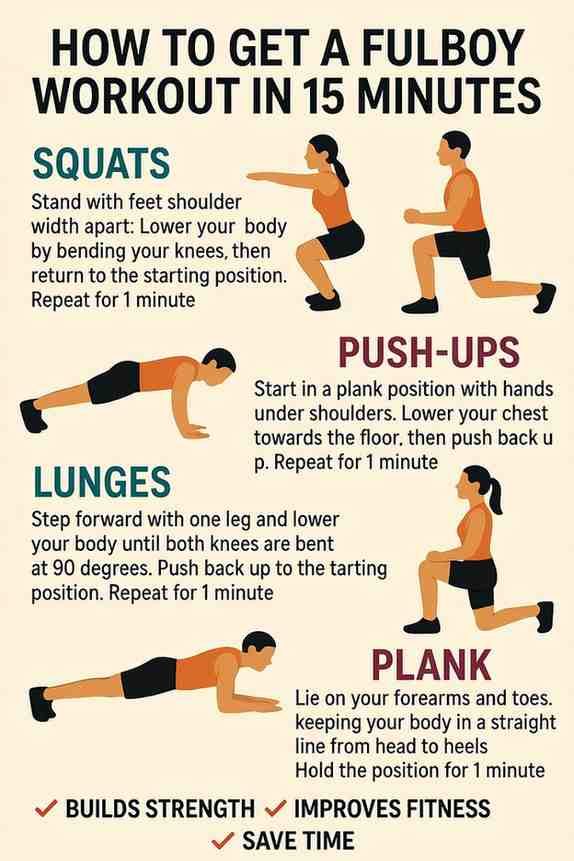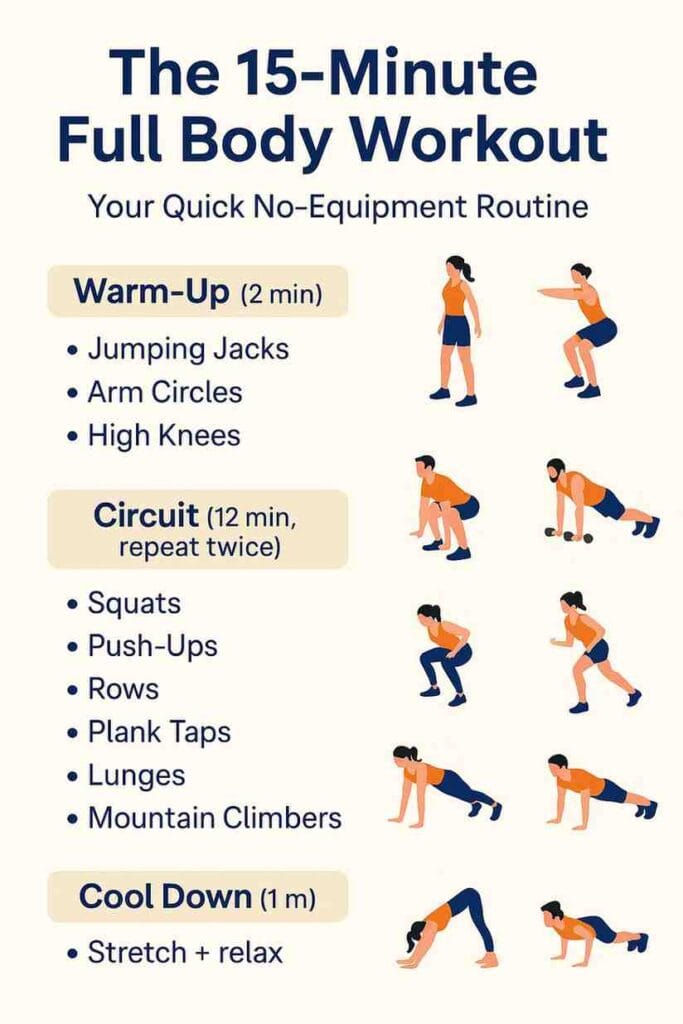Why This Workout Stands Out
Search “15-minute workout” online and you will find the same thing everywhere: a generic list of moves, no science, no real value. This one is different. It’s practical, easy, and backed by the latest research. More importantly, it shows how just 15 minutes a day can change not only your body, but also your health and energy long term.
Can 15 Minutes Really Be Enough?
Yes, and the science is clear.
A 2025 study tracking 72,000 adults found that just 15 minutes of vigorous activity per week (not per day!) lowered the risk of death by 18%, including from heart disease and cancer.
Now imagine what 15 minutes every day can do for you.
Research on HIIT(High-Intensity Interval Training) also proves its power: a 2025 review showed HIIT reduces BMI, body fat, waist-to-hip ratio, and resting heart rate while increasing endurance and VO₂ max.

The reason it works? Compound exercises that train multiple muscles at once-so you get maximum results in minimum time.
The 15-Minute Full Body Workout You Will Actually Want to Do

No gym. No treadmill. No expensive gear. Just your body, a little space, and 15 minutes.
Warm-up (2 minutes)
- Jumping Jacks- 30 seconds
- Arm circles- 30 seconds
- High knees- 1 minute
(This wakes up your muscles and joints so you are ready to move.)
Main Circuit (12 minutes: 40 sec work, 20 sec rest)
Do each move in order, rest briefly, then repeat the whole circuit twice.
- Squats – Legs, glutes, and core.
- Push-Ups – Chest, arms, and shoulders.
- Bent-Over Rows (use water bottles if no weights) – Back and arms.
- Plank with Shoulder Taps – Core strength and stability.
- Reverse Lunges – Balance and leg power.
- Mountain Climbers – Heart rate booster, great for fat burn.
Cool Down (1 minute)
- Hamstring stretch
- chest opener
- Child’s pose
👉 15 minutes, full body covered. Simple, fast, effective.

Why This Works Better Than Typical Routines
Most people waste time with isolation moves or endless cardio. That’s fine if you want bodybuilding or marathon goals, but not if you are just after strength, fat loss, energy and better health.
This quick 15 minute workout keeps your heart rate high, targets large muscles, and triggers the afterburn effect-meaning your body keeps burning calories even after you’re done.
And it’s not that physical: studies show short HIIT sessions also improve memory, focus, and mental clarity.
Make It Yours
- Beginners: Do wall push-ups, shorter plank holds, and slower mountain climbers.
- Advanced: Add jump squats decline push-ups, longer planks.
- Equipment hacks: Water bottles = dumbbells, towel = mat.
This is the 15 minute workout no equipment routine that adapts to your level.
Simple Tips That Boost Results
- Stay consistence: aim for 4 to 5 sessions weekly.
- Quality matters more than speed: form > reps.
- Track progress: note reps, time, or energy.
- Eat well: protein-rich meals aid recovery.
Safety First
If you have heart conditions, Joint issues, or are recovering from illness, check with your doctor first. Push yourself, but never push through sharp pain.
More Than Just Fitness
This routine isn’t about impossible promises like “abs in a week.” It’s about something more powerful: a daily, double reset that strengthens your body, sharpens your mind, and protects your long-term health.
15 minutes is all it takes to go from “I don’t have time” to “I have got this.”
FAQs
Q. Can 15 minutes replace the gym?
If done with intensity, yes. Effort matters more than equipment.
Q. Should I do 15 minutes workout daily?
Most people can, but add a rest day if muscles feel sore.
Q. Does this really help with weight loss?
Yes. HIIT lowers fat, BMI, and trims the waist-to-hip ratio.
Q. Will I feel results quickly?
Most people notice more energy and strength within 2 to 3 weeks.
References
- Harvard Health, 2025 – Short Bursts Reduce Mortality Risk
- Yin H et al., 2025 – Meta-analysis: HIIT and Body Composition
- Frontiers in Physiology, 2025 – HIIT in Cancer Survivors
- BMC Sports Med Rehabil, 2025 – HIIT Improves Metabolic Health
- Nature, 2024 – HIIT and Cognitive Function
- Canadian Science Publishing, 2024 – Low-Volume HIIT Benefits